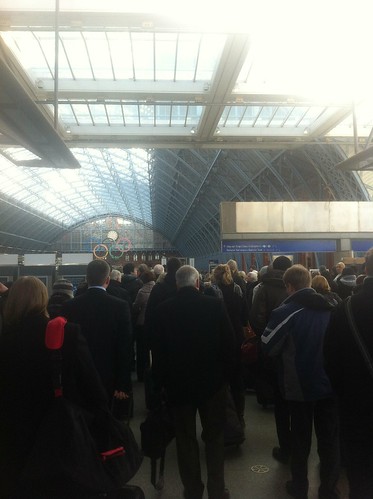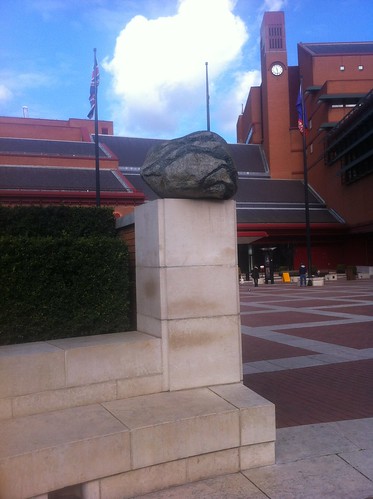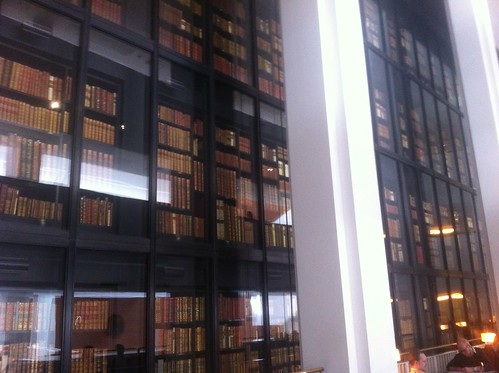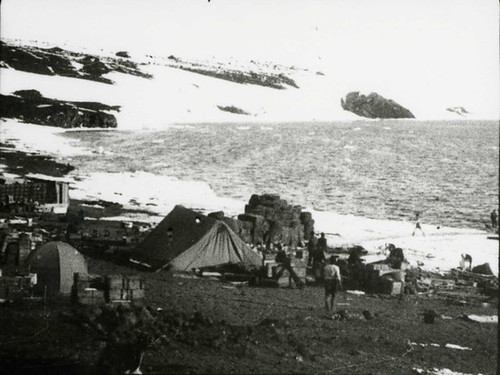In a previous blog post Things to do in London on a Tuesday I asked for suggestions of things to do on my day trip to London. I went because I was invited to attend the inaugural London walking tour from Maths in the City – we’ll get to that – and apparently the date was chosen on purpose as it was a palindrome: 21-02-2012.
On arrival in London, I idly tweeted a photo along the station platform with the caption “Looks like London”. James Clare responded to this with a guess at which station.
I was at St. Pancras. What everyone seems to notice about St. Pancras is the roof, seen in the picture below which I took on the day. This was apparently first opened in 1868 and the 243ft roof created “the largest indoor space in the world“. More recently, an £800m restoration project was completed in 2008. You can watch an interesting BBC short video about this project, featuring interviews with the chief architect, the project director and the project engineer.
Following James’ tweet, I liked the idea of a guessing game so I tweeted a clue for my new location. David Ault guessed correctly that I was at the British Library.
Outside the British Library is a statue of Newton (1995), which had been suggested to me as a destination on my day trip. Designed by Sir Eduardo Paolozzi, who said it was “intended to show how art and science are interconnected”, the statue is inspired by a 1795/circa 1805 colour print finished in ink and watercolour on paper entitled “Isaac Newton” by William Blake, which can be found in the Tate gallery.
Inside the library, I found the King’s library. Created by George III, donated to the nation in 1823 by his son George IV and once housed in the British Museum, these books are housed in an eye-catching six-storey tower (pictured below). A description of how the library was formed and its history is available on the British Library page George III Collection: the King’s Library.
I also visited the Treasures of the British Library gallery, described on the website as “a permanent free display of many of our greatest treasures”. No photographs were allowed but I took a few notes.
I saw a collection of photos and documents from the Scott polar expedition. Fresh from my Twitter photo clue competition, a note caught my eye about the use of photography to increase public interest in Scott’s expedition. The Guardian has a piece about an exhibition of photos from the expedition, which says:
In 1910 and 1911, as Scott struggled to raise funds and public support for the Terra Nova venture – media hysteria about the race to the pole was the reason the South Pole was bolted onto the scientific expedition – the explorer knew the propaganda value of superb images
Herbert Ponting (1870-1935) was hired as expedition photographer. A selection of Ponting’s photos have been uploaded to a gallery by the National Archive and one is available below.
I also saw two pages of notes by Leonardo Da Vinci from Codex Arundel. Leonardo began the collection in 1508, writing that this was “a collection without order, drawn from many papers”. The writing is mirrored Italian written from left to write. According to the British Library website pages were added from different periods in Leonardo’s life, “covering practically the whole of his career”. The website has this to say of the contents:
It includes notes for a book on the physical properties and geographical effects of water, and a broad range of other material encompassing Leonardo’s other interests in art, science and technology over a period of four decades, from the description of a prehistoric sea monster (c. 1478-80) to architectural projects for the royal residence at Romarantin in France (dating to about 1517/1518). The range of subjects – from mechanics to the flight of birds – demonstrates Leonardo’s almost compulsive intellectual curiousity about scientific and technical matters.
The pages I saw in the library were on mechanics and arithmetic. There are pages on the British Library website that show some pages from the Codex Arundel, and an introduction to the Codex.
I also saw an exhibition on early printing, many sacred texts and Magna Carta before moving onto my next stop. That, I’ll save for another post.





Wahoo, think the British Library was my suggestion…glad you found some interesting things there!
Yes indeed it was. Thank you!
P.